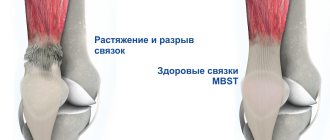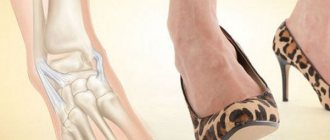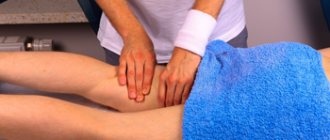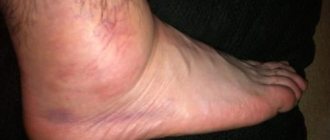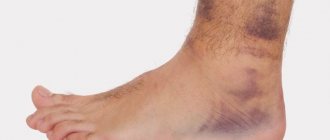Do they provide a certificate of incapacity for work?
A sprain is a tear on the outside of the ligaments. This is a fairly common injury. It can occur at home and at work. Often such damage occurs during sports competitions.
Damage to the ankle ligaments is possible in the following cases:
- hit;
- flip flop;
- a fall.
The following factors increase the likelihood of receiving this type of injury:
- congenital foot deformity;
- wearing uncomfortable shoes;
- carrying heavy objects;
- walking on uneven surfaces;
- excess body weight.
In case of injury, you must go to the emergency room or clinic at your place of residence. There the doctor will open a certificate of temporary disability. You should have your passport and medical insurance with you.
Sick leave for sprained ankle joints is issued depending on the severity of the condition. If the damage is not severe and the person’s ability to work is preserved, then the doctor may not give release from work, but only recommend treatment at home.
If a person experiences severe pain, swelling, or a grade 2-3 injury, then a bulletin is issued for the entire period of treatment and recovery. If the ligaments in the arm are sprained, they may not be released from work if such an injury does not affect the person’s ability to work.
When deciding whether to issue a sick leave certificate, the doctor takes into account the following points:
- the nature and conditions of human labor;
- the patient’s consent to adhere to the selected treatment regimen;
- severity of injury.
If the sprain is severe, you cannot refuse treatment. This can lead to a number of negative consequences. For example, an untreated rupture of the knee ligaments can cause the formation of a Baker's cyst and arthritis. In case of severe injury, nerve rupture and bone tissue fracture are likely.
How long does it take for an ankle sprain to heal?
Trauma to the human foot occurs frequently. Formations of connective tissue are inelastic, so repeated sprains can occur more than once. Damage to the tissues surrounding and supporting the joint limits the mobility of the lower extremities, impairs a person’s ability to work, and takes a long time to heal.
Etiology
The ankle joints, block-shaped in surface shape, are formed by the tibia and fibula, as well as the talus bone of the foot. Between them are ligaments containing collagen and elastic fibers. Such components provide mobility and strengthen the ankle. Sprains in the legs are common. Basically, such injuries occur in people for the following reasons:
- playing sports or strenuous exercise;
- falling from height;
- lateral impact in the ankle area;
- walking on uneven surfaces;
- wearing uncomfortable shoes or items with high heels;
- twisting the leg.
Symptoms
A sprained ligament has the following symptoms:
With such an injury, a hematoma may appear in the joint area.
- pain at the site of impact or dislocation;
- the skin in the damaged area becomes filled with blood (bruises) and swells;
- increased sensitivity of the skin in the injured area appears;
- a minor hematoma forms;
- the normal functioning of the joint is disrupted, and the ability to walk quickly is lost.
Foot ligament injuries can be caused by abnormal limb or bone structure, as well as an anatomical predisposition to ankle sprains.
Can it heal on its own?
Minor sprains go away on their own. The process of complete healing takes a long time, and failure to see a doctor in a timely manner can aggravate the situation.
In order to quickly restore damaged tissue in case of such damage, it is better to consult a doctor in time. He will determine the affected area and prescribe the necessary treatment therapy.
The healing and recovery process depends on the symptoms and manifestations of the injury.
How long does it take for an ankle sprain to heal?
To treat a grade 1 injury, applying an 8-shaped elastic bandage is sufficient.
Rupture of the ankle ligaments at the initial stage (1st degree) is treated and recovered in no longer than 7 days. Rehabilitation after therapy takes another week.
An 8-shaped elastic bandage is applied to the damaged area. The recovery time for a 2nd degree injury is 30-40 days. The movement of the leg is limited by a plaster splint, which must be worn for no more than 10 days.
A grade 3 sprain takes a long time to heal - from 2 to 3 months. Although tissue regeneration after injury takes a long time, the cast can be worn for no more than 3 weeks. In especially severe cases, rehabilitation may be delayed.
After recovery, doctors advise resorting to the following medical devices for the legs:
- fixatives;
- ankle braces;
- ankle orthoses.
Do they give sick leave?
If a person has severely damaged the ligaments in his leg and walks in a cast, then until it is removed, the patient is issued a certificate of incapacity for work. The doctor decides whether to give the patient sick leave. For 1st and 2nd degree sprains, a person is treated at home for 7-10 days.
If the ligament is completely torn, the patient's disability is limited for a longer period. Severe damage to the ligaments and bone requires surgery. After the operation, the damaged areas are fixed with plaster.
The patient is on sick leave for the entire period of therapy and rehabilitation.
Carrying out therapy
To speed up the healing of ligaments, the affected area is lubricated with Deep Relief cream.
It is recommended to treat ligament tears under medical supervision.
The specialist will select sets of exercises and medications necessary for full recovery. The ankle ligaments heal better if rubbed with ointments and creams.
When a skin lesion hurts, it needs to be treated using painkillers. Deep Relief, Diclofenac and Voltaren have a good effect.
Sports activities
Torn ligaments in the foot recover faster if the patient does gymnastics and exercises every day aimed at strengthening the ligaments of the foot. Physical therapy includes the following exercises:
- walking on the outer and inner sides of the foot;
- sitting on a sofa or at a table, moving your toes;
- stand alternately on your heel and toe.
How many days are you suspended from work?
How much sick leave is given for an ankle sprain depends on the severity of the pathology. A first-degree sprain is characterized by microdamage to the ligaments and is treated fairly quickly. Therefore, the period of release from work does not exceed two weeks.
Recovery for a second-degree injury takes 30 to 40 days. With such a sprain, a plaster splint is applied, which must be worn for 10 days. Damage of the third degree of severity takes the longest to heal. In this case, the person is released from work for a period of 2-3 months.
Some sprain episodes require a longer recovery period.
The following factors influence the recovery time:
- patient's age;
- compliance with the treatment regimen proposed by the doctor;
- the effectiveness of the selected therapy;
- the presence of diabetes mellitus (healing with this pathology is longer);
- person's weight;
- compliance with lifestyle recommendations.
What to do if the doctor refuses to issue a sick leave?
There are situations when a doctor has the right to refuse to issue a sick leave certificate. The reason for making such a decision is the simulation of pathology. If a person’s ligaments are in order, he is completely healthy, and his ability to work is preserved, then he will not be given a release from work.
Also, the doctor has the right not to accept a patient who comes to a medical facility drunk or behaves inappropriately or aggressively. If a person refuses hospitalization or the proposed therapy, then the doctor may not issue him a certificate of incapacity for work.
Also, sick leave is not granted to people who are on paid leave. A doctor may refuse to issue a temporary disability certificate if the patient does not have a civil passport.
If a person has a sprain, he experiences pain when walking and needs treatment, then he has the right to apply for a release from work.
If the doctor refuses to issue such a document, then the patient should undergo a series of diagnostic procedures (tomography, arthrography, ultrasound, radiography) and present the examination results for an appointment. Confirmation of the presence of a second or third degree injury is considered the basis for issuing a sick leave.
Expert opinion
Irina Vasilyeva
Civil law expert
If the doctor repeatedly refuses to issue a certificate of incapacity for work, then you can write a complaint against the medical institution in any form and submit it to the regional office of the state health authority. It is important to reflect all the circumstances of the case in the document.
Thus, in case of sprained ligaments, sick leave is issued if the person has lost the ability to work. When making a decision, doctors also take into account the nature and working conditions of the patient. The second or third degree of sprain is the basis for temporary release from work. With such an injury, a person can remain on sick leave from a week to 3 months.
Dear readers, the information in the article may be out of date, take advantage of a free consultation by calling: Moscow, St. Petersburg, Regions 8800-350-97-52
Sick leave for an ankle sprain: is it given and for how many days?
Doctors classify sprains as minor types of injuries. It is accompanied by a complex of unpleasant symptoms and in some cases has a negative impact on ability to work. Therefore, people who have encountered this type of injury have a question about whether sick leave is given for a sprained ligament.
Do they provide a certificate of incapacity for work?
A sprain is a tear on the outside of the ligaments. This is a fairly common injury. It can occur at home and at work. Often such damage occurs during sports competitions.
Damage to the ankle ligaments is possible in the following cases:
- hit;
- flip flop;
- a fall.
The following factors increase the likelihood of receiving this type of injury:
- congenital foot deformity;
- wearing uncomfortable shoes;
- carrying heavy objects;
- walking on uneven surfaces;
- excess body weight.
In case of injury, you must go to the emergency room or clinic at your place of residence. There the doctor will open a certificate of temporary disability. You should have your passport and medical insurance with you.
Sick leave for sprained ankle joints is issued depending on the severity of the condition. If the damage is not severe and the person’s ability to work is preserved, then the doctor may not give release from work, but only recommend treatment at home.
If a person experiences severe pain, swelling, or a grade 2-3 injury, then a bulletin is issued for the entire period of treatment and recovery. If the ligaments in the arm are sprained, they may not be released from work if such an injury does not affect the person’s ability to work.
When deciding whether to issue a sick leave certificate, the doctor takes into account the following points:
- the nature and conditions of human labor;
- the patient’s consent to adhere to the selected treatment regimen;
- severity of injury.
If the sprain is severe, you cannot refuse treatment. This can lead to a number of negative consequences. For example, an untreated rupture of the knee ligaments can cause the formation of a Baker's cyst and arthritis. In case of severe injury, nerve rupture and bone tissue fracture are likely.
How many days are you suspended from work?
How much sick leave is given for an ankle sprain depends on the severity of the pathology. A first-degree sprain is characterized by microdamage to the ligaments and is treated fairly quickly. Therefore, the period of release from work does not exceed two weeks.
Recovery for a second-degree injury takes 30 to 40 days. With such a sprain, a plaster splint is applied, which must be worn for 10 days. Damage of the third degree of severity takes the longest to heal. In this case, the person is released from work for a period of 2-3 months.
Some sprain episodes require a longer recovery period.
The following factors influence the recovery time:
- patient's age;
- compliance with the treatment regimen proposed by the doctor;
- the effectiveness of the selected therapy;
- the presence of diabetes mellitus (healing with this pathology is longer);
- person's weight;
- compliance with lifestyle recommendations.
What to do if the doctor refuses to issue a sick leave?
There are situations when a doctor has the right to refuse to issue a sick leave certificate. The reason for making such a decision is the simulation of pathology. If a person’s ligaments are in order, he is completely healthy, and his ability to work is preserved, then he will not be given a release from work.
Also, the doctor has the right not to accept a patient who comes to a medical facility drunk or behaves inappropriately or aggressively. If a person refuses hospitalization or the proposed therapy, then the doctor may not issue him a certificate of incapacity for work.
Also, sick leave is not granted to people who are on paid leave. A doctor may refuse to issue a temporary disability certificate if the patient does not have a civil passport.
If a person has a sprain, he experiences pain when walking and needs treatment, then he has the right to apply for a release from work.
If the doctor refuses to issue such a document, then the patient should undergo a series of diagnostic procedures (tomography, arthrography, ultrasound, radiography) and present the examination results for an appointment. Confirmation of the presence of a second or third degree injury is considered the basis for issuing a sick leave.
If the doctor repeatedly refuses to issue a certificate of incapacity for work, then you can write a complaint against the medical institution in any form and submit it to the regional office of the state health authority. It is important to reflect all the circumstances of the case in the document.
Thus, in case of sprained ligaments, sick leave is issued if the person has lost the ability to work. When making a decision, doctors also take into account the nature and working conditions of the patient. The second or third degree of sprain is the basis for temporary release from work.
With such an injury, a person can remain on sick leave from a week to 3 months.
Source: https://prozakon.guru/trudovoe/bolnichnyj-pri-rastyazhenii-svyazok.html


